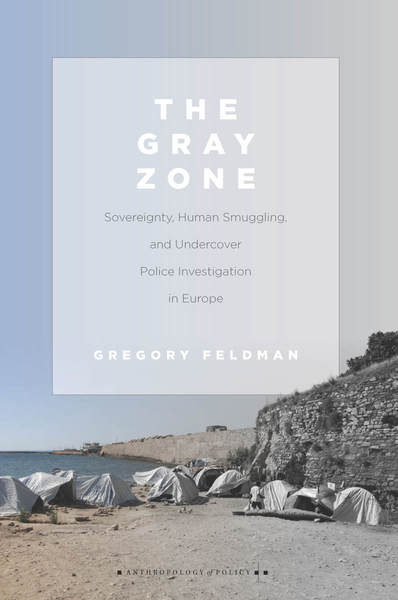Irregular migration has been one of the most popular topics of the political debates in Europe for already a few years. Issues of border policing and border control have regularly made national and international headlines. It is then unsurprising that these questions have attracted the attention of ethnographers who have since tried to understand the relationship between irregular migration, border policing, and state sovereignty and its limits in order to ponder the potential possibilities of reimagining the sphere of the political.

The book opens with an in-depth discussion of two sovereign forms that Feldman refers to throughout the book. The first sovereign form is more vertical, hierarchical, and conceives of equality of the citizens through the principle of sameness. According to Feldman, the first sovereign form is best exemplified by the nation-state. By contrast, the second sovereign form is more horizontal, egalitarian and achieves equality through “equal empowerment” of different citizens (p.14). And it is this elusive second sovereign form that Feldman is interested in. The author claims that his participants strive to imagine and to enact the second sovereign form: thus, he looks at the relationships among the team members, absence of hierarchy within the team, and how the team members negotiate the questions of ethics among themselves. Feldman then contrasts egalitarianism of the undercover police unit with a rather hierarchical structure of the bureaucratic institution of which the unit is a part: according to him, the organization and behavior of this unit provide a glimpse into one of the possible ways to reorganize political space.
Gray zones enable both ethical and unethical action outside the realm of the law.
However, in order to understand any sovereign form, it is imperative to take a look at the gray zone that is the sine qua non of any sovereign form. The gray zone, according to the author, is not so much a place as “an effect of human relations” (p.17); it is a “point in space-time free of the constraints and contours of moral code and law” (p.17). What is most prominent and important about the gray zone is that it shines a light on “tendencies already present in normal order” (p.25) by exaggerating them, by making them more pronounced. Thus, the author’s insistence that the “difference between the normal order and the gray zone is a matter of degree, not of kind” (p.25). Consequently, looking at the way his participants behave “in the gray zone” enables the author to hypothesize about the tendencies that might be present in the second sovereign form.
After laying out theoretical premises, the next four chapters of the book, building on the ethnographic data, discuss the co-existence of the two forms of sovereignty and their gray zones. Chapter one introduces the investigative team that Feldman was a part of and describes how the team’s egalitarian orientation, deep familiarity with each other, and empathy for their “targets” shape the team’s actions in the gray zone. Feldman insists that the team tries to distance itself from a more hierarchical bureaucracy that it is a part of by asserting the principle of egalitarianism. For instance, according to the author, the team’s formal leader foregoes “the hierarchy and its incumbent command structure” (p.67): instead of giving orders, he allows all members to present their assessments of a situation and to persuade each other to take a certain course of actions. Feldman praises the team’s emphasis on a dialogue as this preserves the personhood of each team member that would otherwise be “lost in a hierarchical arrangement” (p.67) because simply following orders does not require “thinking assessment … of the ethical validity and significance of what should be done” (p.67).
The team members had to enter the gray zone and break the law for the sake of the investigation and for the sake of their own consciences.
Chapter two explores the topic of violence and sovereignty. It argues that it is the negotiated principle of honor that regulates the team’s actions in the gray zone: the team’s actions are based not “on universalised notions of right and wrong but rather on shared understandings of what those notions should be” (p.104). In other words, the chapter discusses how the team distinguishes between what is ethical and what is legal (since these two categories don’t always overlap). Feldman describes situations when the team members exceeded their authority (e.g. they used physical force against one of the suspects and broke the law by illegally entering the suspect’s premises) in order to do what they all deemed to be “the right thing” (p.79). The author argues that in the eyes of the team, breaking the law was justified because of the ends the team pursued: to catch the leaders who operated a human trafficking ring. As Feldman puts it, “they [the team members] had to enter the grey zone [e.g. break the law] for the sake of the investigation and for the sake of their own consciences” (p.79).
Chapter three continues the discussion of (il)legality and ethics started in the previous chapter by elaborating the topic of secrecy and its uses by the team and the state. Zooming in on the process of recruitment of informants and on surveillance, Feldman shows that despite the fact that secrecy is necessary for the first sovereign form (i.e. the state) because of security concerns, the team doesn’t find secrecy to be appealing—rather, they find it frustrating because secrecy imposes limits on the scope of what the unit can do, while at the same time preventing the team members from effectively showing their work to the public.
Chapter four takes the discussion of sovereignty and gray zone to the international level. Exploring the limits of the first sovereign form and its shadow areas, Feldman focuses on the team entering the gray zone in order to deal with three international clandestine crime networks, consisting of an illegal brothel in a rural area that tailored to middle-class clients and employed women migrants; a sex trafficking ring that trafficked young women from Nigeria; and a Roma criminal ring that focused on begging, pickpocketing, burglary, and prostitution.
Feldman’s approach to police ethnography is original and innovative for at least two reasons. Firstly, it is an incredible example of studying up as it offers a glimpse of the lives of actors who act on behalf of the state and routinely deal with vulnerable and marginalised populations. Feldman portrays his participants with a lot of empathy in his discussion of their ethical dilemmas and ways to legitimise “bending the rules.” Secondly, because of the sheer scope of theoretical questions that the book engages with, it shifts the conversation from talking about what the police do to talking about the various networks that the police are embedded in. This therefore highlights why they do what they do and what the implications of those actions are.
It is difficult to overstate how thought-provoking The Gray Zone is, and therefore it is unsurprising that the book’s unconventional approach leaves the reader with myriad of questions.
It is difficult to overstate how thought-provoking The Gray Zone is. It is thus unsurprising that the book’s unconventional approach leaves the reader with myriad of questions. One of these is how the author actually conceives of the state. On the one hand, Feldman consistently uses the state as an example of the first sovereign form; on the other, he insists from page one that “states don’t do things; people do” (p.1) and that “there are no such things as states, only actions conducted in their names by particular people” (p.1, emphasis in original). But where does this leave the investigative team? The team’s actions and considerations are influenced by the institutions that the team is embedded in; moreover, the team acts on behalf of the state and for the state, just as the team targets’ act despite the state or against it. Thus, the state, or the idea of the state and the understanding of the consequences of disobeying this idea, are constantly on people’s minds.
Feldman’s ambivalence about the state seems to stem from the fact that to view the state as the first sovereign form presupposes treating the state as a coherent unity, which it isn’t. This leaves Feldman claiming the non-existence of states as entities. However, instead of completely denying the existence of states as entities, it is possible to nuance the view of the state as a coherent entity by bringing into the conversation Matthew Hull’s Government of Paper and Elif Babül’s Bureaucratic Intimacies. Based on ethnographic fieldwork with Pakistani bureaucrats, Hull refuses to treat the state as a unitary entity that is capable of total control and manipulation and proposes instead to theorize it as an assemblage of various documents, discourses, and practices that mediate relationships between people and organizations. Likewise, Elif Babül, based on her ethnographic research of the process of translation of human rights in Turkey, insists that the state is rather a fiction of unity: it is a patchy and uneven constellation of institutions and discourses. Such approaches to the state could have brought good middle ground to The Gray Zone’s two extreme views of the state.
There are no such things as states, only actions conducted in their names by particular people
If gray zones enable both ethical and unethical action outside the realm of the law, how do we reconcile the actions of the team and of their “targets,” given that what is ethical in the gray zone is a product of a group’s shared understanding? In other words, Feldman’s take on the gray zone also provides us with the possibility of understanding and explaining the actions of the criminal networks that the team acts against. Are the ethical standards of the team and that of their targets commensurable and reconcilable in the gray zone? And how do the “criminals’” shared understandings of (il)legality and ethics fit in with the two sovereign forms? Though the book does not really discuss it, it would have been really interesting to see the author engage with the themes of ethical relativism and ethical pluralism.
Overall, the fact that the book elicits so many questions indicates the novelty and power of Feldman’s approach. The Gray Zone defies the expectations of what an ethnography is by bringing to the fore complicated theoretical questions and reconsidering them through the details of the undercover police team’s work.
References:
Babül, Elif M. 2017. Bureaucratic Intimacies: Translating Human Rights in Turkey. Stanford, California: Stanford University Press.
Hull, Matthew S. 2012. Government of Paper: The Materiality of Bureaucracy in Urban Pakistan. Berkeley: University of California Press.
This book review is a response to Allegralab’s call for reviews on Law, Technology and Bureaucracy
Featured Image: Metal02 by Betty Hime, Flickr, (CC BY 2.0)










2 Comments